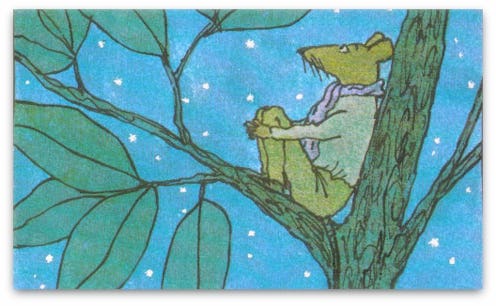Books
#TBT Reads: William Steig Ruled Childhood Books

You know you love an author when you keep changing your mind trying to decide your favorite book they've written. For Judy Blume, it's Summer Sisters ! No, it's Deenie , or wait, Just As Long As We're Together! With Lorrie Moore it is definitely either Self-Help or A Gate at the Stairs, depending on how I'm feeling when you ask. And when I think about Ann Patchett, I'm certain the best is Truth and Beauty, but then I remember what it felt like reading Bel Canto.
When I was a kid, this is exactly how I felt about William Steig. When story time rolled around, it was impossible to choose which of his picture books I wanted in the 20 minutes before bed, or which I'd sit with when I got home from preschool.
Steig spent most of his career as a cartoonist and illustrator for The New Yorker, which explains why his books are both so beautiful and precise. He didn't even begin writing picture books until he was in his 60s — so all you people who think you must know what you're doing for the rest of your life by the time you turn 30 can rest easy on that. He wrote more than 30 picture books after that, well into his 90s, and he won the Caldecott Medal at the fresh, young age of 69 for Sylvester and the Magic Pebble.
Because Steig has a birthday in November, it seems the appropriate time to celebrate our favorites of his childhood picture books.
Sylvester and the Magic Pebble
Sylvester and the Magic Pebble may have been the first of Steig's picture books to win the Caldecott Medal, but it certainly wasn't the last. And it has the distinct honor of being banned because police officers in the story are depicted as cartoon pigs — though, as you can see clearly from even the cover, the pigs aren't just cops, they're town inhabitants.
Steig's story is a moving fable about Sylvester the donkey who comes across a magic red pebble. He thought about how, with this pebble, he and his family could have everything they ever wanted. When a lion came along, he was so afraid that he wished himself into a rock to hide. But as a rock, he wasn't able to hold the pebble and turn himself back into a donkey. Sylvester's family was distraught looking for him, and Sylvester was devastated that he'd never return home to them. In the end, he is able to wish himself to be himself again, and everyone realized they didn't need magic, they already had everything they ever wanted in each other.
Doctor DeSoto
Ugh, Doctor DeSoto, about a mouse dentist who has to treat a fox with a toothache, is so adorable I can barely deal. I loved all of the different contraptions he used to treat animals of all sizes.
The fox secretly (or not-so-secretly if you've studied the food chain) plans to eat the kind mouse dentist, but Doctor DeSoto manages to out-fox the fox by saying that mouth glue was part of the treatment of his toothache, so he physically could not chomp down on his prey.
An animated short of Steig's book was nominated for an Academy Award.
Shrek
Never forget: Though he's now more closely associated with Mike Myers, everyone's favorite lovable green ogre was originally a Steig creation. The basic storyline has stayed the same: An ogre ventures out to explore the world and ends up saving a princess. In Steig's original creation however, that princess was even uglier than Shrek.
The Amazing Bone
The Amazing Bone won so many awards that it would be hard to count. The story of a bone that could not only talk, but could imitate any sound captured the imagination of both adults and children. And notably, it's one of the first of Steig's books that featured a female main character, in this a pig named Pearl. Pearl and the bone become great friends, and the bone helps her escape many misadventures (of course, there's another evil fox) with wit and cunning.
Brave Irene
It's impossible to not cheer on Irene. Even Al Gore loves Brave Irene . When her dressmaker mother gets sick, Irene must get the dress she made to the dutchess in time for the ball. She pushes through insane wind, snow, and every other obstacle that comes her way to get the job done, showing young girl readers everywhere that where there's a will there's a way. With some guts and determination, you are always stronger than you think.
Abel's Island
Little mouse Abel is the Robinson Crusoe of the animal kingdom. It's one of those stories that moves you in ways, as an adult, you can't imagine a picture book ever really could. Abel is stranded on a deserted island, separated from his true love, his wife Amanda, and he's facing harsh conditions that force him to face the world in ways he never did in his civilized world. My heart broke over and over, each time Abel builds a family out of clay sculptures or held close to his wife's scarf. Finally, after a particularly difficult winter, Abel decides to fight the cold, turbulent waters and swim back to his home, and yes, I cried and cried when he made it.
Steig manages in around 30 pages to meditate on the philosophies of survival, love, and character that many literary fiction authors have trouble capturing in more than 300 pages.
Amos & Boris
How could you not fall in love with the two best friends, the mouse Amos and the whale Boris? We could all learn from what Steig has to say about finding common ground and empathy in the most unlikely places, and how coming from different worlds doesn't mean you're all that different after all. Again, in his own simplicity, Steig is able to say something so profound.